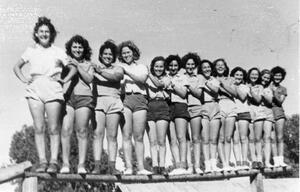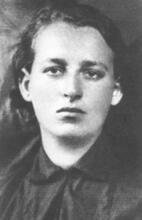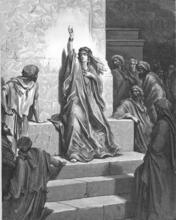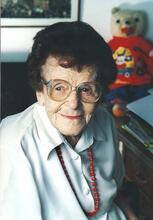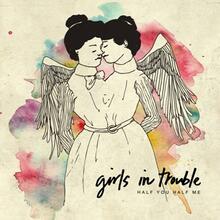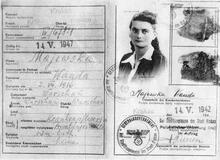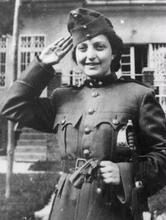Palmah
Women in Palmah training at Kibbutz Dafna, 1947.
Source: Palmach Archive, Yiftach 3rd Battalion, Volume 4, album 3/9, via Wikimedia Commons.
The image of the woman of the Palmah, with a rifle on her shoulder fighting alongside the men, was deeply rooted in the myths of the fight for a Jewish state. But this depiction reflects only part of the story. Women, like men, brought a variety of skills, strengths, and motivations to their voluntary service, including defending the Zionist movement and serving alongside men, but as early as 1942 women were perceived as physically weaker and relegated to more traditionally feminine tasks. This division of labor persisted during the War of Independence. The experiences of the relatively few women who protested this segregation contributed to the myth of the Palmah woman, which became significant in the decision to make military service compulsory for young women in Israel.
Introduction
Discussion of women’s military service in both pre-state Palestine and later has focused more on the need for participation and partnership than on the issue of equality of the sexes. Women’s participation in the Haganah, the Palmah, Ezel (Irgun Zeva’i Le’ummi), and Lehi (Lohamei Herut Israel) during the struggle for statehood, as well as their role in the Israel Defense Forces (IDF) during the War of Independence, generated a sense of joint achievement, the result of common effort and sacrifice. It also engendered a feeling of having conquered a stronghold, a bridgehead in the fight for gender equality which must not be surrendered.
These feelings were incorporated in the National Service Act of 1949, which transformed women’s military service from an expression of the need for a special effort in times of conflict and war into an essential element in the education of the Israeli girl, and the abstention from service into something exceptional or even unacceptable. Above all, women’s military service became one of the outstanding and “exemplary” expressions of Israeli society’s tendency toward equality of the sexes—a characteristic much stressed by the country’s media, the educational system, propaganda, and public relations. A frequently cited model of such equality was women’s participation in the Haganah’s special forces Palmah (Pegulot Hamahatz, “striking force”), which was formed in 1941and was active through Israel’s founding. The army was depicted as a legitimate sphere of female activity, one where women would be enabled to develop professionally and to display their abilities and talents.
“Where, oh, where are these girls … with their shabriya (curved dagger)?”

Shula Sadlovsky of the Palmah's Yiftah brigade holds a rifle in her lap while looking through a pair of binoculars, ca. 1948. This image typifies the mythical "Palmah woman" that pervades Israeli military history.
Source: Palmach Photo Gallery The Palmach Photo Gallery, from PikiWiki.
Women’s membership in the Palmah contributed significantly to the decision to make military service compulsory for young women. The image of the woman of the Palmah, with a keffiyah (scarf) on her head and a rifle on her shoulder, fighting alongside the men, accompanying convoys to Jerusalem, operating a walkie-talkie at the height of battle or tending to a wounded warrior, was deeply rooted in the tales of the war and during the early days of statehood gradually grew to mythic proportions. In the eyes of the next generation of young Israeli women these women of the Palmah were heroes, one link in the chain of a kind of “combat heritage” of women in The Land of IsraelErez Israel. To what extent can such an ideal be perceived during the Jewish community in Palestine prior to the establishment of the State of Israel. "Old Yishuv" refers to the Jewish community prior to 1882; "New Yishuv" to that following 1882.Yishuv period—or is this in fact essentially the story of a battle for the right to such a heritage?
Up to the outbreak of World War II the phenomenon of women active in defense, the underground, or battle was limited. In 1925, five years after the establishment of the Haganah, women—mostly members of the Labor movement—began to join the organization and were assigned to the tasks of first aid and transport of weapons, but were not taught how to use such weapons. Although they constituted more than twenty percent of the total membership, their role was so insignificant as to make the late 1920s and early 1930s a period devoid of outstanding female figures.
Pressure exerted by women A voluntary collective community, mainly agricultural, in which there is no private wealth and which is responsible for all the needs of its members and their families.kibbutz members brought about a change in the policy of relegating them to insignificant roles. In August 1936 it was decided to give women military training. In especially designed courses, they were instructed in the use of rifles, pistols, and hand grenades and command of military positions. While the real-life results seem to have been negligible, Batsheva Haikin, a member of the En-Harod kibbutz, was among the eight representatives of the Histadrut appointed to Haganah headquarters in 1937 and in the following year three women kibbutz members participated in a course of patrol leaders in the field units.
The outbreak of World War II saw an impressive growth in women’s participation in the military, first at the initiative of WIZO and Mo’ezet ha-Po’alot via volunteering for the British army and later, in more modest proportions, for the Palmah. Despite strong male opposition, some 5,000 women volunteered for the British Army from 1942 to 1944, constituting approximately one-sixth of the total number of volunteers.
All at once, it became possible for women to participate in the war effort without being “protected” and blocked by their menfolk. In retrospect, it is clear that the women’s voluntary service in the British army brought about a significant, though not immediate, change in male attitudes to the idea of women’s military service: even if they could not wholly accept it, men could no longer deride it or oppose it, especially in view of its dimensions. In any case, it seems to have brought about the decision to accept women to the Palmah, initially (between 1942 and 1943) on an individual basis and later in greater numbers, with the addition of the women from the Hakhsharot ha-Meguyassot, whom youth movements in Europe had prepared for kibbutz life. However, the women expressed their dilemma: While favoring their right to join the armed struggle, they had profound reservations regarding actual combat, which inevitably involved killing. In other words, the path to equality lay in the battlefield, and a woman who sought “liberation” could not bypass this section of the route.
“I went—because a voice called.”
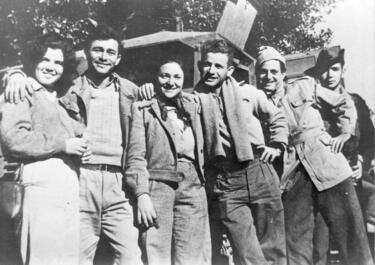
Men and women escorts to a caravan pose for a group photo, 1948. Among the reasons women volunteered to join the Palmah were to fight and train alongside men and assist the war effort on the frontlines.
Source: Palmach Photo Gallery The Palmach Photo Gallery, from PikiWiki.
The first “official” conscription of women to the Palmah was in May 1942. The first six companies, totaling 600 fighters, included 60 women, one patrol per company. Henceforth, women were recruited to the Palmah, first only on an individual basis and later also as part of the Hakhsharot ha-Meguyassot. At the time of the War of Independence, when its numbers reached their peak, the Palmah had 6,000 recruits, of whom 1,000 were women. As was the case for all the organizations and bodies of the Yishuv, membership in the Palmah was voluntary. In 1988, a meeting of veteran women members was entitled “I went because a voice called.” Nevertheless, it is worth detailing just what that voice said to the individual members, and not just to the group as a whole.
What emerges from a series of interviews conducted by Ayah Savorai in 1984 and 1985 is a variety of motives, the chief among which was indeed a response to the call. Others were the spirit of voluntarism, a desire to defend the homeland, a desire to rescue European Jewry (through serving in the Yishuv units of the British forces fighting Nazi Germany), impatience with an imposed passivity, and a search for adventure. One distinct group among the Palmah women was that of members of the Hakhsharot ha-Meguyassot, for whom “togetherness” was an important element in their participation. Just as in the case of the male members of the hakhsharah (“preparation,” name for agricultural programs and training centers that prepared young Jews for Lit. "ascent." A "calling up" to the Torah during its reading in the synagogue.aliyah), their joining the Palmah had been a collective decision, which involved a certain degree of “acceptance of the collective” rather than personal choice. They stressed the strong connection to the group and their order of priorities—first the kibbutz and then the Palmah, and obedience to the movement’s decisions. Young women from religious families, as well as Holocaust survivors, also joined the Palmah.
All the motives have certain elements in common in that they reflect the yearnings and inclinations of both young men and women to pursue a great vision, one which instills a sense of importance and maturity; to experience adventures; to court danger; to be part of a group; or to escape from an authoritarian and protective home.
Things were far more complex for two other groups of recruits: those young women who sought to realize their desire for equality and to prove to themselves and to those around them, especially the men, their abilities and talents, not necessarily just on the battlefield; and those who joined the Palmah in order to engage in combat, just like the men, on the grounds of total equality between the sexes and out of a readiness to undergo the most stringent of tests in order to achieve that goal.
Some of the women argued that equality did not necessarily involve sameness; women could, as on the kibbutz, perform equally important but different tasks, although some might well be capable of joining the men in combat. Thus women could be trained in topography and the use of small arms. The fact that they were not involved in combat should not relegate them to an inferior status.
Most of the individual women who joined the Palmah in 1942 and 1943 did so in order to train for combat alongside the men. Their physical and emotional investment, their high expectations both of themselves and of their surroundings are evident in their memories, even many years later, when some of them recall those times with pride and satisfaction, while for others the memories are tinged with frustration, disappointment, and pain.
In later years, similar goals motivated some of the members of the Hakhsharot ha-Meguyassot, who rejected both the “feminine” image that their male colleagues sought to impose on them and the traditional division of labor in times of war, when men went to the front while women stayed, helpless, in the rear. This differentiation may have been unacceptable because of the experience of World War II, in which the civilian population was severely affected and the distinction between battlefront and the home front, between combatants and the protected, became irrelevant. Or perhaps it was the struggle of women to be involved in guard duties during the riots of 1936–1939, when they refused to accept their role as the protected and the passivity imposed on them by the men. However, the prime—and most recent—influence was that of the women who had volunteered in the British army and who now, in 1946, had returned home with accounts of their experiences in wartime, even if these did not include combat duty.
Gradually, the notion of women’s participation in fighting became normative. One justification given for this by some women was the need to protect the home and the family, but others spoke specifically of a desire to participate in the main battle itself, as combatants and in no other role. For most of the women their choice of the Palmah stemmed from two sources: one was the feeling that they were joining a body that was fulfilling an important national function, highly esteemed by the Yishuv leadership, while the other was the sense of distinctiveness they felt in serving there as women. The resulting tension between consensus and non-conformity invested their choice with special value.
The “Individual” Women in the Palmah
In 1942 and 1943 women, especially of the Labor Settlement movement, began joining the Palmah as individuals, not as part of a group. With their recruitment there began a process of formalizing women’s participation through trial and error, with no prior definition of goals, apart from a desire to be partners on as equal a footing as possible. Various experiments were conducted; at first the women were trained separately from the men, then together with them. Though this change was in many respects satisfying, the women soon felt that a special effort was required of them in order to perform the physical tasks imposed on the group, which in some cases seemed greater than the demands made on their male colleagues. Many were wounded in their attempt to prove themselves equal to the men in the exercises imposed on them. As a result, they began to question the notion of equality as equated with identity, sameness.
In the summer of 1943 the “woman question” came to the fore, resulting in a meeting of the women Palmah members at Mishmar ha-Emek in September. Two major reasons for the meeting, which also influenced the decisions taken, were the combined experiences of the first year of service, on the one hand, and the need to prepare for the incoming Hakhsharot ha-Meguyassot, whose recruitment had been under discussion since the beginning of 1943. The 30 “veterans” discussed whether it was fair to expect the young women of the hakhsharot, who constituted 50 percent of the total group, to experience the same conditions as themselves; to demand of them—who had undergone no medical examination—what they had demanded of themselves. The problem was not one of knowledge, in which they were in no way inferior to men, but in physique. Hence the need to change to a different tempo for the women, a different quantity, but nevertheless to insist on attaining equal results, while suiting the effort to ability. As for positions of command, the intention was to present the (female) officer as a personal example, a role model, and to stress the faith in ability rather than the element of competition. While some of the old-timers saw this as giving up, the majority thought it a wise decision. It eased the absorption of the hakhsharot, which was of prime importance to the continued existence of the Palmah at the time, since all the glory and attraction lay with the British forces, while the Palmah, which aroused little enthusiasm, was composed entirely of the Labor settlement members. Hence the importance of enabling the hakhsharot to join.
At this meeting a decision was made to separate the women’s training from the men’s and establish separate units of women under women commanders. This decision predicated a lowering of expectations and relinquishment of the desire to equal the men in achievements and duties. The Alon ha-Palmah (The Palmah Journal), which reported the meeting, noted two major points: First, there was a defining of the limits of equality: on the one hand, providing basic training equal to that of the men, “while also creating conditions and an atmosphere which will give [her] self-confidence to do everything she is able, but not more than she can do.” Second, there was to be a wider range of duties that women would fulfill: not just communications and paramedics, which would greatly limit the number of women who could be absorbed. It was suggested that they should be trained for such non-combat duties as quartermasters and cooks, administrators and instructors, and one of the speakers suggested perhaps even for patrolling and reconnaissance.
This was certainly neither an expression of despair nor an admission of failure on the part of the women but rather a clear-headed re-evaluation based on a year of hard and sometimes apparently frustrating experience. It was an attempt to fit themselves for an eventuality that might well come about in the future, to which they would have to respond even if it were counter to their nature as women: truth to tell, they argued, women did not delight in battle, but represented the home, children, everyday life—and peace.
If this was so, why did these women choose to remain in the Palmah, whose declared aim was training combatants? Three reasons emerge from the discussion.
Firstly, in the forthcoming inevitable armed struggle it would be irresponsible to forgo the participation of one-half of the population. Secondly, women had to be trained for combat in order to protect their homes and families should this prove necessary. Finally, at a time of real, critical challenge, the women might prove unexpectedly and surprisingly competent even in battle.
The February 1944 issue of the Palmah Journal was devoted entirely to the question of its women members. Its contents reflected both the experiences, feelings, and self-image of the women and also the attempt of the shapers of the Palmah’s character to define the women members’ identity and status, to outline their duties and expectations and yet at the same time to strengthen their sense of belonging and their worth, despite their physical limitations. The better part of this journal was then devoted to what today would be termed “Combat Tradition,” but in its female form.
Significantly, the male leaders’ attempt to define the women’s function and status was tenuous in the extreme. What further increased the vagueness of the definition was a reference to that “spirit” which, together with the physical elements, comprised the military unit, even constituting twice the value of the physical. It would be the women’s function to provide this vital element. Other writers stressed the valuable contribution of Palmah service to women’s image and self-image, thus presenting service in the Haganah and Palmah as instrumental in attaining the ultimate goals of women’s social status. (It is worth mentioning that when the War of Independence broke out, many women, like Nativa Ben-Yehuda, considered this personal goal as insignificant and even ridiculous at a time of national struggle.)
A contribution by the Palmah physician clearly depicted women’s physical limitations and suggested recruiting only those sufficiently strong and healthy to cope with the strenuous training, and even then the ultimate duties should be appropriate to women’s physical strength. Women were physically at their best between the ages of eighteen and 22, the physician said, but one must not overlook their ultimate function—childbearing.
The overall impression derived from reading the words of the women themselves is one of wavering between the desire to continue their struggle for equal status within the Palmah on the one hand, and doubts and lack of faith in their own abilities, disappointment, and frustration on the other. Nevertheless, the women perceived themselves as morally superior to those of their age-group who were not in the fighting forces.
The final section of the journal, which dealt with the ongoing “Combat Tradition” in its female form, cited the examples of Deborah, Judith, the women of Masada, and, in more recent times, the heroines of resistance in the ghettos, such as Frumka Plotniczki.
The attempt to create a recruited force composed of both men and women equal in duties and status was thus short-lived. As early as 1942–1943 the physical limitations of the majority of the women were quite clear and therefore separate training was created. Nevertheless, until the establishment of the CHEN (Women’s Corps of the Israel Defense Forces) in 1948 no clear decisions were formulated to define the nature of women’s duties, thus leaving wide scope for individual initiative and action on the part of those women who were not prepared to accept the restrictions imposed on them.
The Hakhsharot Ha-Meguyassot
When the Hakhsharot ha-Meguyassot joined the Palmah in 1943, the proportion of women rose from ten to approximately 30 percent and a completely new non-selective sector was introduced, who joined not as “individuals” but as a group, not necessarily out of a desire to serve in the Palmah but simply because this was the result of their decision to join a hakhsharah. Their impact on women’s status and duties proved considerable.
While Ha-Mahanot ha-female/sing.; individual(s) who immigrates to Israel, i.e., "makes aliyah."Olim youth movement was the first to discuss joining the Palmah, the first movement to do so was the No’ar Oved, four groups of which joined between March and July 1943. Their entrance into this elite Palmah framework was not a success; the young women, in particular, were distressed by their inferior status. In 1943 the Palmah approved the proposal of the Kibbutz ha-Meuhad leadership to accept each hakhsharah in its entirety as a group composed of both men and women, without removing anyone or adding other recruits.
Composed of equal numbers of men and women, these groups posed a problem for the Palmah, which preferred a ratio of one-third women to two-thirds men in its companies. Nevertheless, the Palmah acceded to the demands of the hakhsharot, and the predominant element in the memoirs of the hakhsharah women is that of the life “together,” the common background of the youth movement. What was most significant for them was precisely this joint recruitment as a hakhsharah, rather than their joining the Palmah, which was altogether secondary in their estimation. Perhaps it was precisely because the Palmah was less important than joining a kibbutz, that these women were less concerned with participation in training and combat than with being together with their male comrades. They thus fared better socially and so far as morale was concerned even during the War of Independence, accepting women’s non-participation in combat and deriving the most from maintaining contact with their group, being near the fighting men and caring for them.
In the first and third battalions from which the Yiftah brigade was formed in the War of Independence it had so high a proportion of members from the hakhsharot that, in the words of its commander Yigal Alon, “It could have been nicknamed the Blue Shirts Brigade. The significant number of women not only contributed to the physical attractiveness of the brigade but also to improving its morale, strengthening its structure and improving its services. The women even participated in the combat units.” Yet although women constituted forty percent of the brigade, the book dedicated to the brigade which appeared in 1970 had not a single woman among its editors. Only the illustrations bear witness to their presence, yet the very few women contributors to the book stress that they experienced a true fellowship with the men in the war effort and did not perceive themselves as merely an attractive element contributing to maintaining the men’s morale.
In fact, most of the women in the Yiftah brigade largely fulfilled a maternal role, washing and ironing the men’s clothes, preparing the beds for their return, placing a bar of chocolate and a vase of flowers alongside. “They served as fighters, radio operators, clerks, medics, quartermasters, but they were also ‘mothers.’” Every squad had two such “mothers.” The headquarters company was composed primarily of women.
In the entire Yiftah Brigade there were only three women officers—a women’s officer, a welfare officer, and, in the third battalion, a communications officer—and this despite the significant number of women in the battalions who worked in administration, communications, quartermaster’s stores, education, and culture.
The War of Independence brought out most clearly the seemingly insoluble conflict engendered by the intake of the hakhsharot in their entirety: on the one hand, establishing the Palmah as an elite unit and, on the other, including women and physically less able men. The Palmah urgently needed the men, not only because they were the major source of manpower at the time (1943–1944), but also because they were a select group, intelligent and highly motivated. But the men came with their female fellow members and to this problem the Palmah at first had no solution.
The years that elapsed between the first recruitment of the hakhsharot and the War of Independence enabled the transformation of the Palmah into a “recruited youth movement.” The members spent most of their time together in the work camps and training in the kibbutzim in which they were posted. Here the military aspects of their training did not predominate, both because of its underground, partisan, and informal nature and because of the everyday, civilian environment. Although this environment of the kibbutz was inconsistent with the norms and demands of a military unit, it served as a successful breeding ground for the unique social experience of the recruited youth movement.
As for the young women, these years developed within them a great degree of identification with the group of which they were a part—both the close, intimate hakhsharah and the larger Palmah. Thus, when the war broke out, revealing the difference between the expectations and what actually occurred, they were not only unable but also unwilling to engage in open disagreement.
Courses and Military Operations
In 1989 Rina Dotan, who had served in the Palmah, conducted a survey of its women members and their functions in the brigade. 198 (approximately one-fifth of the total number) responded to her questionnaire. She found that while the entire range of occupations was supposedly open and identical for both sexes, the women were in fact posted in only a limited number, either of their own free choice or at the command of their (male) superiors. The reasons given stemmed both from concrete situations and from social preconceptions relating to physical limitations and fear of capture by the enemy.
The first group in her survey comprised officers, combatants, patrol members, and demolition experts—the most prestigious of the military occupations—but they had in fact served primarily as trainers or women’s officers. From 1943 until 1947 only ten women served as company commanders. Very few indeed served as officers or saboteurs during the war itself. Three women who rate special mention were the paratroopers Hannah Szenes, Haviva Reik, and Surika Braverman (who was never sent on a mission). The major operations in 1946–1947 included the infiltration at Atlit, the blowing up of railroad tracks; “Wingate Night,” helping in the landing of illegal immigrants; and “The Night of the Bridges,” in all of which very few women appear to have participated. Only three of the respondents had participated in the release of prisoners from Atlit, in which a total force of 60 Palmah members took part. Nine women participated in the various stages of illegal immigration, among the “Gideonites,” in accompanying the ships and landing on the beaches, and in training the immigrants while they were still in the camps on Cyprus.
During the war itself women seem to have played only minor roles in actual combat. Apart from those who accompanied the convoys during the first few months of the conflict, there were no patrols or groups of women in combat. If they did participate, it was as a result of an extraordinary policy on the part of an individual commander, through personal contacts, or in a particularly serious situation which led women, on their own initiative, to join in the fighting. On the other hand, there were very many women at the front, serving in various modes of assistance.
In addition to positions of command, patrolling and sabotage were the most prestigious occupations. Of the respondents to the questionnaire, five had passed a course in patrolling and two a course in sabotage. (One of these, Nativa Ben-Yehuda, fought as a sabotage officer during the fighting in the Galilee at the beginning of the war.) As for the remainder, 58 had taken a course in communications, 32 were medics, and 29 were patrol commanders. The first two of these areas combined combat and rear activity and indeed there were women who served in the fighting in both these capacities, either as a result of prior planning or because of developments during the fighting. As for the patrol commanders, they were primarily in charge of all-women patrols of the mixed group of the Hakhsharot ha-Meguyassot and their number increased significantly from 1945 on.
Other groups included seventeen sport instructors—a fairly arduous task since they trained both men and women—and ten who engaged in armed training and the care of arms. Two were drivers and a few had been trained in preparing maps and sun prints, camouflage, pigeon post, and Hebrew teaching and culture. (The latter two were courses initiated only after the beginning of the War of Independence.) A full 30 percent of the respondents (58 in number) had never participated in any kind of specialized training. We can assume that the majority of these were members of the hakhsharot, who preferred to remain part of their hakhsharah group rather than leave it, as necessitated by taking a training course. For them, it was enough to have left home, to participate in a mixed group in fairly intimate circumstances and close to the “action.”
Some twenty percent of the respondents (38) mentioned that they had taken more than one training course, thus indicating impressive motivation, a desire to test themselves and to find the professional area which would enable them to play a meaningful part in the imminent struggle, especially in a framework marked by ongoing lack of clarity as to the nature of their participation in that struggle once it began.
Women were active in a number of major special operations. These included the second blowing up of the radar station at Givat Olga (January 20, 1946), the “Night of the Bridges” (June 17, 1946), and “Wingate Night” (March 27, 1946), when a Haganah and Palmah unit attempting to help illegal immigrants on the S.S. Wingate to land in Tel Aviv was attacked by British forces. Bracha Fuld (1927–1946), the commander of the Palmah unit, was killed in the action. Women also participated in ongoing operations such as the “Northern Unit,” which brought illegal immigrants from Syria and Lebanon. They trained the “Defenders” in the Cyprus camps and served as “Gideonites” abroad and as radio operators on the ships.
All of these actions were carried out by small groups, sometimes even by a single individual, either following orders received from a distance or quite independently, displaying initiative, resourcefulness, and courage. Indeed, various elements of illegal immigration seem to have been the most appropriate form of service for the women: independent underground action, often equal to the men’s in value and risk, in instances that required the individual to determine his/her own modes of action and response, using a variety of skills of which physical strength and combat ability were only of secondary importance.
“She stood at the window and watched…”
One way of evaluating the relationship between women and their male colleagues in the Palmah is by examining the songs of the period. Sung to this day, especially on memorial days and at reunions, they reveal how deeply rooted were traditional attitudes and stereotypical images dealing with the relationship between the sexes. The Palmah Family: A Collection of Stories and Songs, compiled by the “Palmah poets” Chaim Gouri and Hayim Hefer, provides invaluable evidence of a sexist and patronizing attitude to women. Their proper place, according to these texts, is at home. The recurring images are those of the “boy” setting out for battle taking leave of his beloved, who remains behind, or of the man at the front yearning for her. Sadness, tears, loneliness, and longing—these characterize the woman, who stands at the window, stays on the strand or wanders in the orchard. There is virtually no mention of women alongside men—in work, in training, or on marches. It appears that such a presence, which undoubtedly existed in reality, did not fit the fundamental romantic conception from which the songwriters were unable to free themselves. A woman who cannot be longed for, who lives here and now in the everyday life of the camp and perhaps even shares the same trials and experiences as the men, is unsuited to be the subject of a love song. Woman is a part of the home to which the man expects to return once the war is over. She is gentle, loving, and beautiful, an object of desire and longing rather than a fighter, and that is how she appears even when she joins in the fighting. (Cf. “Chizbat”: “I recall Tzipke in battle. Intent from head to foot, She was a cutie [!] like an apple in autumn./She was mighty—and deadly!”)
In the later songs of the Chizbatron troupe the women do appear as partners, not so much in training and in battle, but in sharing the memories: the grandmother who recalls bandaging grandfather’s wounds in “Those Were the Days” (“Hayyu Zemanim”) or Rina in “The Meeting,” who “speaks all day long of the march into the desert.” Perhaps this change is a result of the participation of women in the troupe, although frequently the women’s role in the song stresses male machismo in combat and her feminine childishness. For example, in “The Jeep,” Rina nags Itzik until he allows the “little girl” to hold the wheel for a while. She is delighted—“I’m the (woman) driver”—which is rather strange, given the number of Palestinian Jewish women who were lorry (truck) drivers in the Auxiliary Territorial Service (ATS) during World War II!
Some of the songs are less romantic and far more vulgar, depicting the women in their age-old role as camp followers. Referring to the song “When We Went to the Palmah,” the authors also attribute to the women a further reason for joining the Palmah: “The girl referred to in the song waited two years for her beloved. … When she saw that he wasn’t returning, she joined the unit. That accounts for the girls who were with us.”
Every now and again a woman fighter appears in the collection or there is some reference linking the woman to combat rather than to home. In “Come Off It, Motke” (“Dahilak, Motke”), it is Shula who attaches the fuse to the detonator and puts the gelatinite in her rucksack. Similarly, in “It’s Possible” (“Hen Efshar”), “your sad room … calls both of us back from battle, paths and autumn.” The song “We Came Here” (“Banu Heinah”) memorializes Bracha Fuld, who was killed on “Wingate Night.” The song is not named after her and the fact that she was a fighter is only hinted at; in fact, it is not she who is the subject of the song, but rather the “we,” who “came here” and who sing the song “about ourselves.”
The overall impression created by the well-known Book of Tall Tales (Yalkut ha-Kezavim) by Dahn Ben-Amotz and Hayim Hefer is of an all-male society. The women are hidden under the generalization of “girls” (“ha-banot”), while the men are identified by first name, nicknames, and, in particular, deeds. While the authors probably did not deliberately intend to ignore the women, their absence nevertheless reflects their role in the Palmah experience as anonymous, passive spectators of the male protagonists, but never participating with them.
The Palmah may have recruited women to its ranks and the discussion of their status, talents, and roles may have continued throughout its existence, but the songs and the popular culture continued to reflect the traditional differences in the roles of men and women and they are somehow more authentic and convincing than the corrective memories of the women or the apologetics of the men. Perhaps the best expression of this ignoring of women is to be found in the Palmah hymn. At a conference on women in the Palmah held at Yad Tabenkin in 1986, a woman’s cry was heard from the audience: “I sang the Palmah hymn for years and I want its wording corrected to ‘Every good man to arms, every woman [instead of “every man”] on guard.’ I want this call for change to go forth from here.”
The War of Independence
Regardless of whether or not they had previously served on an equal basis with men, the status of women in the Palmah changed completely during the War of Independence: they were excluded from combat and confined to supporting roles. The Palmah Book contains an admission of the dimensions of the problem: since no attempt was made to exploit the women’s abilities, their very participation in the brigade became questionable. Many of the women found themselves with nothing at all to do. This was especially culpable given the shortage of manpower, which could have been supplied by the women. It was not so much the feelings and responses of the women that concerned the commanders as the shortage of manpower should they leave the Palmah completely.
Some of the women responded by proposing different, less “aggressive” roles for themselves: defense duties, communications, guard duty, accompanying convoys, training, and administration, all of which could easily be transferred to the women without making them feel that they had no role to play or that they were somehow inferior to the men. In fact, women had been accompanying convoys to Jerusalem since December 1947, apparently at the initiative of individual companies rather than because of official policy. There was also a difference between the Yiftah Brigade, in which most of the women were from the hakhsharah, and the Harel Brigade, where most were “individuals.” In the latter, women did engage in more active combat duty, including clearing the road to Jerusalem.
Only in August 1948 was more serious attention given to the women’s role in war and the need for special training for their tasks as adjuncts in supplying services rather than in combat. However, women still received military training, in order to maintain their enthusiasm, while greater stress was laid on the importance and value of work of any kind. To the women of the hakhsharot and others who had joined the Palmah more out of a desire for “togetherness,” the changes were wholly acceptable, but those who had aimed at equal opportunity and equal status underwent a considerable crisis as they attempted to reconcile themselves to the new reality. They consoled themselves by stressing the importance and even the essential nature of services. Combat might be important, but even soldiers had to eat, dress, wash, and be part of a society, and so far as facilitating these activities was concerned, the women had a vital role to play. Ironically, however, the historiography of war in general focuses solely on the military activities, thus entirely ignoring women’s participation.
Comparatively few women refused to reconcile themselves to their inferior status as non-combatants, continued to fight for their right to be included and even succeeded in their struggle, but it was precisely their experience that helped to create the myth of Palmah women’s role in combat. In the early years of statehood this myth had incredible educational value, but the time has come to re-evaluate it.
The ambiguous role of women in the Palmah is best expressed in illustrations in two of the Yiftah journals of 1949. While one is a sketch entitled “The Palmah Girl” which shows a young woman with a kerchief on her head, wrapped in an apron and with a broom in her hand, the other is a cover photograph of a young woman with stocking cap, holding a sub-machine gun, leaning against what seems to be an armored car, smiling as in a “posed” portrait.
Six years of joint living and training together, even if in separate groups, intended to prepare them for joint service, years in the course of which women participated in various military actions, were not enough to eradicate the traditional differentiation of the tasks respectively suited to the two sexes. The war denied women the choice which had seemed so real when they first joined the Palmah and which had indeed existed, in one form or another, until the war began.
Ben-Amotz, Dan and Hayim Hefer. Yalkut ha-Kezavim (Book of Tall Tales). Tel Aviv: Ha-Kibuts ha-meuhad, 1956.
Gilead, Zerubavel and Matti Megged. Sefer ha-Palmah (Book of the Palmah). Tel Aviv: Ha-Kibuts ha-meuhad, 1953.
Gouri, Chaim and Hayim Hefer. Mishpahat ha-Palmah: yalkut ‘alilot va-zemer (The Palmah Family: A Collection of Stories and Songs). Jerusalem: The Palmah Organization Press, 1974.
Gozes-Savorai, Ayah. Sapri li sapri li: haverot Palmah mesaprot (Tell me, tell me: Palmah companies tell all). Tel Aviv: Ha-Kibuts ha-meuhad, 1993.
Talmi, Menahem, Aviezer Golan, and Emmanual Katz. Lohamei ha-chofesh be-Yisrael: toldot ha-shomer, ha-haganah, ha-palmach, nili, etzel, lehi (Freedom Fighters in Israel: History of Hashomer, Haganah, Palmah, Nili, Etzel, Lehi). Tel Aviv: Hotsa’at S. Friedman, 1955.

